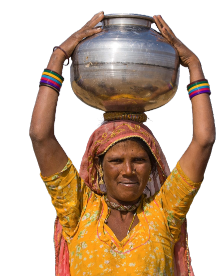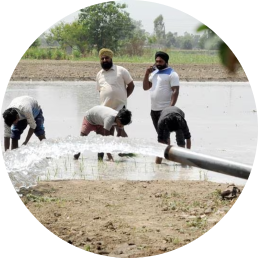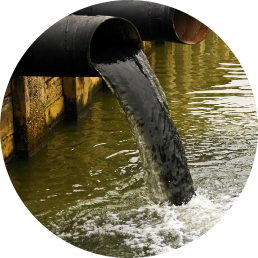Provision of safe and clean drinking water, thereby enhancing the overall quality of life

Water is an invaluable resource that sustains life and plays a pivotal role in the development of any society. However, with the growing population and increasing demands for water, ensuring its availability has become a significant challenge. Amrit Gram recognizes the importance of treating water as a precious resource and employs advanced technologies to optimize its usage, reduce wastage, and secure a sustainable supply for its residents.
Amrit Gram integrates innovative technologies and sustainable practices to create a harmonious and efficient community. Among the crucial interventions required for a smart village, the management and utilization of water resources stand out as a fundamental aspect. Amrit Gram delves into the various ways in which advanced water management can contribute to the overall sustainability and prosperity of the community.
Under water as an intervention, Amrit Gram is currently working on the following:
Provision of safe and clean drinking water, thereby enhancing the overall quality of life

In rural Indian villages lacking a water purification plant, multiple challenges associated with water quality and public health can surface. These problems primarily arise from insufficient access to safe and clean drinking water.

Without a water purification plant, rural villages often resort to natural water sources like rivers, ponds, or wells. These sources can be contaminated with bacteria, viruses, parasites, and harmful pollutants. According to the World Health Organization, over 80% of wastewater globally returns to the environment without being treated or reused.

The consumption of contaminated water leads to a high risk of waterborne diseases such as cholera, diarrhea, typhoid, and hepatitis, which disproportionately affect children and vulnerable populations. A report by the Indian Council of Medical Research (ICMR) reveals that diarrheal diseases are the third leading cause of childhood mortality in India, largely due to unsafe water.

Substandard water quality can result in a variety of health complications, including gastrointestinal issues, dehydration, malnutrition, and stunted growth, compromising the overall well-being of the community. According to UNICEF, 38% of children under five in India are stunted, with poor water quality being a contributing factor.

In areas where women are primarily tasked with water collection, the absence of a water purification plant can exacerbate their burden as they have to travel long distances to fetch water, which is frequently unsafe to drink. As per the United Nations, women in rural areas of developing countries spend an estimated 25% of their daily time budget on collecting water.


The installation of a water purification plant in rural villages can effectively address these challenges, providing access to safe and clean drinking water, thereby fostering improved public health, curbing the prevalence of waterborne diseases, and enhancing the overall quality of life in rural communities. Prioritizing the establishment and maintenance of such facilities is a crucial step towards ensuring sustainable access to safe drinking water for all, creating a healthier and more prosperous future for these communities.
Rite Water provides solar powered community water purification plants. These plants run on solar power and have following components:
As the plants are powered by solar energy, there is a great savings on electric bills which has been a big challenge for similar electricity based plants, making the solar based plants sustainable for small habitations and villages.

The solar-based water purification plants provided by Rite Water offer a significant advantage in terms of cost efficiency. Traditional electricity-based purification plants often face substantial operating costs, making them financially burdensome for small habitations and villages. In contrast, the solar-powered plants offer substantial savings on electric bills, ensuring cost-effective water purification. This cost efficiency not only makes clean water more accessible but also drives the sustainability of these essential facilities, enhancing the overall economic well-being of rural communities.

Access to a reliable and consistent water supply is essential for the health and well-being of rural communities. Rite Water's solar-powered water purification plants guarantee a dependable source of clean drinking water. The combination of solar submersible pumps and efficient purification technologies, housed in a prefabricated shelter, ensures a resilient and efficient water dispensing system. Through card/coin-based vending mechanisms, residents can access clean water easily. This reliability enhances the quality of life, curbs waterborne diseases, and contributes to a healthier, more prosperous future for the villages we serve.


The establishment of a water purification plant in rural India can catalyze substantial positive changes across various aspects of life, with notably significant effects on public health, access to safe drinking water, and overall community development:
The most immediate impact of a water purification plant is the assurance of clean, safe drinking water. Through purification processes such as filtration, disinfection, and chemical treatment, harmful contaminants, pathogens, and pollutants are eliminated, thereby ensuring the water meets quality standards for safe consumption.
Access to safe drinking water substantially reduces the incidence of waterborne diseases such as diarrhea, cholera, typhoid, and hepatitis. Enhanced water quality significantly lowers the risk of waterborne illnesses, leading to improved public health outcomes, especially among children and vulnerable populations.
Access to safe drinking water directly uplifts public health, decreasing the prevalence of water-related illnesses and bolstering overall well-being. This leads to a reduction in healthcare expenses and hospitalizations, fostering a healthier population.
Water purification plants also contribute positively to environmental preservation. By treating and purifying water, the discharge of pollutants, contaminants, and untreated wastewater into natural water bodies is significantly curtailed, safeguarding local ecosystems and minimizing environmental pollution.
Water purification plants encourage responsible water management practices. With the presence of such facilities, communities become more conscious of the importance of water conservation, proper wastewater disposal, and sustainable use of water resources.
Improvements in public health and reductions in waterborne diseases have a positive ripple effect on economic productivity. Healthier individuals translate to increased workforce participation, reduced healthcare costs, and heightened economic well-being for the community.
Establishment of water distribution networks, installation of water purification plants, and creation of community-based water management systems.

In rural Indian villages where the last mile delivery of purified water is often unattainable, the local population can encounter several challenges related to accessing safe and clean drinking water. These challenges can manifest as follows:

The absence of a robust last-mile delivery system may force the village population to continue relying on potentially contaminated water sources like rivers, ponds, or untreated wells. This exposes them to waterborne diseases and various health risks. The World Health Organization estimates that half of the world’s population will be living in water-stressed areas by 2025.

The consumption of untreated or contaminated water can trigger waterborne diseases such as diarrhea, cholera, typhoid, and hepatitis. The lack of access to purified water amplifies the risk of water-related illnesses, particularly among children and vulnerable individuals. The World Health Organization reports that each year, unsafe water, sanitation, and hygiene result in an estimated 1.7 million deaths worldwide.

In the absence of a reliable water delivery system, villagers — especially women and children — must invest significant time and effort in collecting water from distant and often polluted sources. This diverts time from other productive activities like education and income-generating work. According to the United Nations, women and girls in developing countries spend an estimated 200 million hours daily collecting water.

Women and girls, who are typically responsible for water collection in rural communities, bear the brunt of inadequate last-mile delivery. This not only affects their physical health but also constrains their opportunities for personal and economic development.

The absence of reliable last-mile delivery of purified water can perpetuate poverty by limiting economic opportunities, escalating healthcare expenses, and obstructing overall development in the community. As per the World Bank, the economic cost of poor sanitation and hygiene, including healthcare costs, is estimated at $260 billion annually.


Addressing these challenges necessitates the implementation of effective last mile delivery solutions. These include the establishment of water distribution networks, the installation of water purification plants, and the creation of community-based water management systems. Ensuring access to safe and clean drinking water is a fundamental requirement for fostering health, well-being, and sustainable development in rural Indian villages.

Empower local communities by involving them in the planning, implementation, and management of water delivery systems. Establish water committees or cooperatives to supervise water distribution and maintenance, thereby promoting local ownership and sustainable water practices.

Introduce Water ATMs at strategic locations within the village, providing residents with convenient access to purified water. Utilize a prepaid card or mobile payment system to ensure that this critical resource is both accessible and affordable to all.

Leverage solar-powered water purification systems, particularly in regions with limited access to electricity. This approach ensures sustainable, eco-friendly water treatment while also harnessing the abundant solar energy available in most rural Indian locales.


The implementation of last-mile delivery for purified water can yield substantial positive impacts on rural villages, addressing water-related challenges and fostering comprehensive development. Here are the key benefits:
By establishing a last-mile delivery system for purified water, we ensure that the village population has access to safe and clean drinking water. This vital measure reduces the risk of waterborne diseases and elevates public health outcomes.
Access to purified water decreases the incidence of waterborne illnesses such as diarrhea, cholera, and typhoid. This leads to improved overall health, reduced healthcare expenses, and a lighter disease burden within the community.
Improved public health and a reduction in waterborne diseases positively influence economic productivity. A healthier population can participate more actively in the workforce, leading to increased economic opportunities and robust community development.
Last-mile delivery of purified water diminishes reliance on potentially contaminated or overexploited natural water sources. This aids in protecting local ecosystems and preserving the environment.
The last-mile delivery approach curtails the time and effort villagers, especially women and children, spend fetching water from distant sources. This liberation of time can be channeled towards other productive activities, enhancing overall household efficiency.
Access to safe drinking water through last-mile delivery promotes social and gender equity by ensuring that all community members, regardless of their social or economic status, have equal access to clean water. This policy fosters a sense of inclusivity and fairness within the community, contributing to broader social cohesion and development.
Community-centric approach that reinforces water conservation, embraces sustainable practices, promotes community involvement, and underscores proper governance.

Rural Indian villages face a multitude of challenges concerning water source sustainability. These issues are often amplified by factors such as population growth, shifting weather patterns, and escalating demands for water resources:

Groundwater, a vital source of water in rural communities, is under threat due to excessive and unregulated extraction for irrigation and domestic use. This overexploitation can lead to aquifer depletion, rendering them unsustainable and causing wells to run dry. According to the Central Ground Water Board of India, around 29% of the country’s groundwater blocks are semi-critical, critical, or overexploited.

Rivers, ponds, and lakes in rural areas often suffer from overuse for irrigation, livestock watering, and other activities. This overexploitation leads to reduced flow and potential drying up during arid seasons, disrupting the availability of surface water.

Water sources in rural villages are susceptible to pollution from various sources, including agricultural runoff, improper waste disposal, and lack of adequate sanitation facilities. The World Health Organization (WHO) suggests that over 80% of wastewater generated globally returns to the environment without adequate treatment, indicating a widespread risk of water contamination.

Climate change, marked by erratic rainfall patterns and prolonged droughts, can severely disrupt water availability. This makes rural villages, already grappling with water supply challenges, even more susceptible to water scarcity. A report by the Intergovernmental Panel on Climate Change (IPCC) indicates that by 2020, 75 to 250 million people in Africa are projected to be exposed to increased water stress due to climate change.

Inadequate water management practices, such as the absence of rainwater harvesting, proper water storage, and groundwater recharge, contribute to water wastage and diminished source sustainability. The United Nations reports that around 2 billion people worldwide live in countries experiencing high water stress, underscoring the need for better water management practices.


Addressing these challenges calls for a holistic, community-centric approach that reinforces water conservation, embraces sustainable practices, promotes community involvement, and underscores proper governance. Fostering water source sustainability in rural Indian villages is vital for ensuring a dependable, clean water supply, bolstering agricultural productivity, enhancing public health, and driving overall community development.

Educate communities about the importance of water conservation. This education should cover water-saving irrigation techniques, the use of water-efficient appliances, and the prevention of water wastage in day-to-day activities.

Establish robust water quality monitoring systems to routinely evaluate the health of water sources. This system will enable the prompt detection and resolution of contamination issues, preserving the quality of the community’s water supply.

Initiate awareness campaigns to enlighten the community about the significance of water source sustainability, the necessity for proper sanitation, and the detrimental consequences of water pollution. These campaigns can promote behavioural changes and encourage responsible water use.

Strengthen water governance mechanisms at the local level. Empowering communities to manage their water resources efficiently will equip them to collectively address water-related challenges and ensure the sustainability of their water sources.
By incorporating these strategies and tailoring them to the distinctive needs and challenges of each rural community, we can effectively encourage water source sustainability in rural India. Such a comprehensive approach guarantees a reliable, clean, and long-term water supply, underpinning livelihoods, agriculture, and overall well-being in rural villages.


Incorporating these solutions for water source sustainability can yield an array of positive impacts in rural Indian villages, drastically transforming the water landscape and catalyzing comprehensive community development.
The implementation of watershed management and sustainable water practices aids in protecting natural ecosystems. This contributes significantly to the conservation of the environment, preserving biodiversity and maintaining the health of the natural habitats.
Adopting strategies for climate resilience, such as the cultivation of drought-resistant crops and the establishment of efficient water storage systems, equips villages to better withstand the impacts of climate change. This resilience ensures continued access to essential resources, even in the face of environmental uncertainty.
The integration of water conservation strategies and groundwater recharge practices works to alleviate water scarcity. This ensures a more reliable water supply, even during dry seasons, thereby reducing the stress and hardship associated with water shortages.
The integration of these solutions aligns with the principles of sustainable development, fostering long-term viability and equitable access to water resources. This approach ensures that all community members can enjoy the benefits of clean and safe water, now and in the future.
The implementation of these solutions promotes knowledge sharing and the propagation of best practices among villages. This encourages a broader adoption of sustainable water management practices across rural India, amplifying the impact and fostering a culture of sustainability and water stewardship.
We believe that together, we can make a real impact. Join us today and take a step towards building a better tomorrow!

Rite Water is excited to introduce Amrit Gram™, a ground-breaking concept aimed at creating self-sufficient, self-sustaining, and future-ready model villages in India, to the recipient. This initiative is aligned with the vision of the Honorable Prime Minister of India, Shri Narendra Modi, for a utopian golden period in India called “Amrit Kaal.”
© 2023 Amrit Gram. All rights reserved.